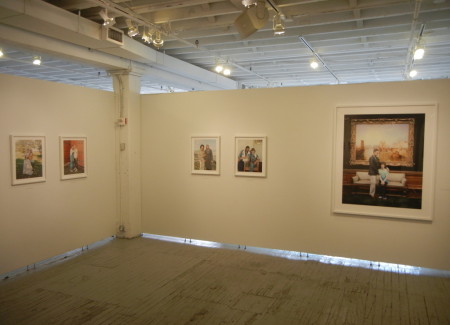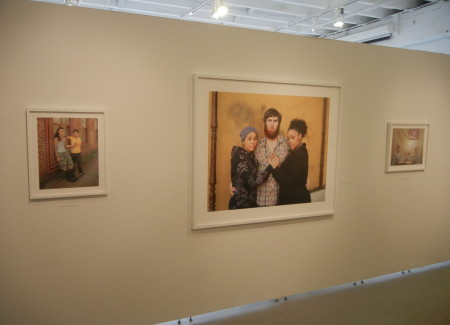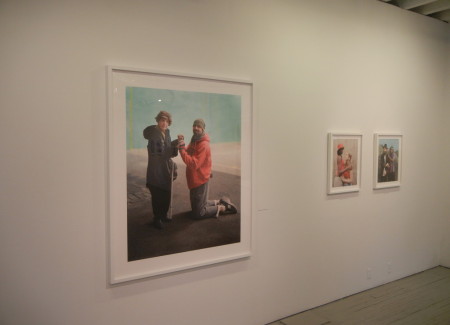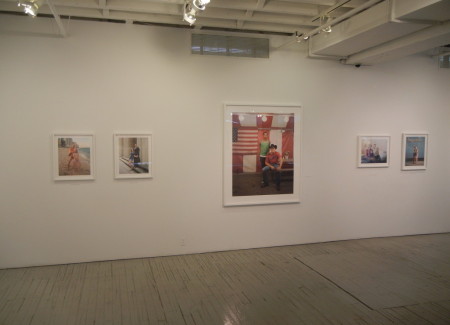JTF (just the facts): A total of 32 color photographs, framed in white wood and unmatted, and hung against white walls in the large single room gallery space. All of the works are archival pigment prints, made between 2007 and 2013. The prints are shown in one of two sizes: 40×50 (in editions of 3) or 16×20 (in editions of 7), or reverse. There are 8 prints in the large size and 24 prints in the small size on view. A monograph of this body of work was recently published by Aperture (here) and is available from the gallery bookshop. (Installation shots below.)
Comments/Context: The temptation to make fun of Richard Renaldi’s Touching Strangers is hard to resist. The high concept of asking two or more people who don’t know each other to touch in front of a camera is so uplifting in a Ken Burns-spirit-of-American-democracy-way that PBS should be giving away copies of the Aperture book as part of its next fund drive.
Sure enough, the lofty sentiments of the project caught the eye of Steve Hartman, whose segment from the CBS Evening News plays on a monitor in the gallery. “New York Photographer Turns Strangers into Friends” reads the wishful headline on the website. Renaldi has shown us, in Hartman’s sanctimonious words, “humanity as it could be.”
Of course, the true stranger in these interactions is the photographer with his large-format camera. Renaldi has chosen his subjects (with help from street-level wranglers) not so much at random but according to what he imagines will create pictorial friction or unforeseen harmonies as he puts bodies together inside a frame. Geographic proximity seems less important as a factor in the pairings than whatever differences in age, race, gender, modes of dress, or religious practices Renaldi guessed would be visible.
How much affection or discomfort will each socio-economic combination manifest for each other in front of the nosy, inquisitive camera? That’s the dramatic question asked by the pictures.
The unexpected answer is that, despite its contrivances, the project has generated a fair number of affecting portraits. Renaldi is most successful when he doesn’t interfere too much and try to update Norman Rockwell. When he settles for obvious contrasts—as in the portrait of a young man in a red baseball cap cradling a pale blonde girl (“Chris and Amaira, Chicago”) or an African-American woman in a black dress hugging a white-haired elderly woman in tie-dyed slacks (“Elaine and Arly, New York”)—the stiffness of his poses is apparent.
It is when Renaldi relaxes his grip on the need to draw a larger picture of the country’s rainbow demographics that his gifts for formal portraiture emerge. My favorite examples here include a Latino couple wedged next to an ice machine and under an ATM sign outside a bodega (“Atiljan and Tiffany, Bronx”); a pair of nattily dressed white fellows, old and young, standing with linked arms outside a church on the Upper East Side (“Bill and Travis, New York); and an interracial couple with two children sitting on the edge of a bed (“Sonia, Zach, Raekwon, and Antonio, Tampa”).
Renaldi’s project resembles in its title and raison-d’etre Joel Sternfeld’s monumental series “Stranger Passing” (1985-2000) except that Sternfeld came upon his subjects by chance and didn’t mix and match them in order to suggest parables about post-millennial America. It is particularly unfortunate that Aperture chose as the book’s cover a portrait of a cop embracing a young woman wearing a shirt decorated with the stars and stripes. We are already well aware which country is being assessed in this series and overt comparisons to Robert Frank don’t favor Renaldi.
I couldn’t help wondering what constituted a failed portrait in his mind. (The results here are not “first takes,” as Teju Cole reminds us in an essay.) Were there any ugly incidents in the outtakes as he tried to force uncooperative strangers to stand still and pretend to be temporary pals? Much as the intrusive director in the 1970s TV series American Family inspired Albert Brooks’s mockumentary Real Life, the forced conviviality of Touching Strangers risks becoming its own parody.
What saves it from that fate is Renaldi’s sober approach to portraiture (he has favored unsmiling expressions and face-forward address in the manner of August Sander) and the natural grace of strangers. Which one of us, when asked politely by an agreeable man with an expensive camera, wouldn’t be happy to stop for a few minutes and have our picture taken with a stranger? So long as we’re not expected to be friends.
Collector’s POV: Richard Renaldi is represented by Bonni Benrubi Gallery (here) in New York and the works on view in this show are being sold directly by the gallery, not by Aperture. The 40×50 prints range between $8000 and $14000, while the 16×20 prints range between $4000 and $7500. Renaldi’s work has little auction history, so gallery retail remains the best option for those collectors interested in following up.














The review is too kind -” banality “- would have been a more apt observation without the pretense that the “snapshots” have any merit other than being snapshots .